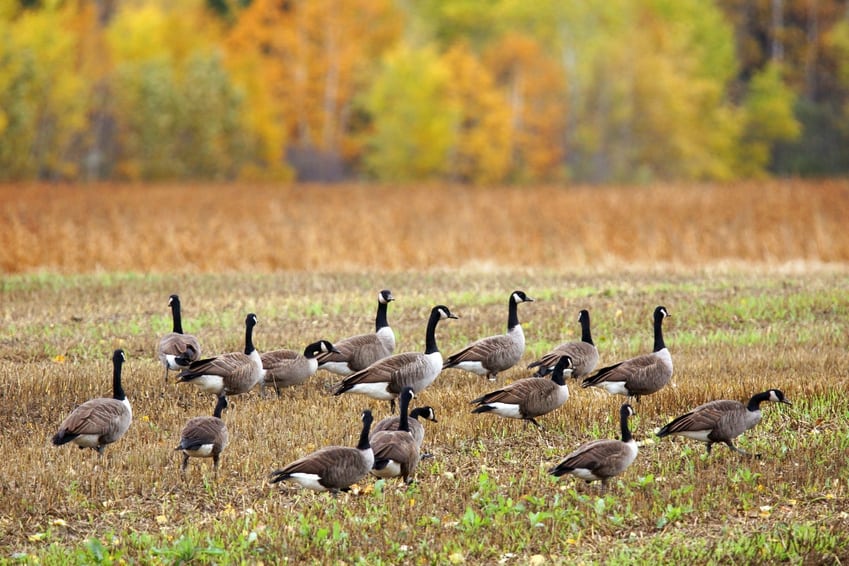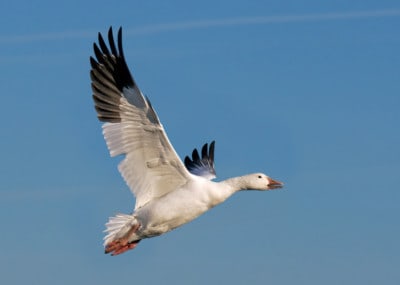Here we will be covering another great bird hunting sport for all of you, hunting geese. So what are geese? Are they the same as hunting ducks? Well we are here to tell you that geese share a very different set of habits than their neighborly duck. While these big birds do share the same type of water source for swimming and feeding, lakes and large ponds, they tend to fly from location to location, namely open crop fields.
Hunting geese:
Let’s talk about geese habits. As we have said, geese like to go from spot to spot, but you will primarily see them in one of two places. They will be either feeding on a green pasture, or swimming. Let’s start with the pasture.
You probably guessed already that geese absolutely love eating grass, and you’re exactly right. These spots are a great place to decoy geese and you can even find them feeding here in the snow. These geese don’t ever miss a meal unless the weather is terrible. Even if there is snow on the ground, if it is sunny you can bet they will feed. You can find these birds feeding usually twice a day, once after first light, and once right before the sun sets.
So now you may be thinking, “How about when it rains, or snows?” Even though geese will still feed when the ground is wet or snowy their habits change when there is an oncoming storm. Geese can barely fly in the rain, so their bodies react to temperature and humidity changes in a very sensitive way. When they sense there is an oncoming storm, they will stop feeding and flock together.
Also, we know from our 3 goose tips you’ve never heard, that geese are very sensitive to fog and low light conditions. You won’t see geese moving too far when it is not very visible outside. Geese are in alert mode when the visibility conditions are very poor, so they won’t be feeding or sleeping when the weather is like this.
Geese also migrate come every winter, but not far. They usually won’t go farther south than the most northern states in the USA so not to worry if you live in the United States.
So what does this mean for you? Of course it means pay attention to the weather and habits of the geese in your area all year so you will have no trouble come hunting season. We should base our hunting habits after the habits of our prey so know when and where these geese will be.
Main types of geese:
Light Goose
For your upcoming goose hunt, we will be highlighting two types of geese. The first one is the light goose. The light goose, or the snow goose as it is sometimes called, has been recently the topic of conservation, so hunting of light geese will only be allowed during a specific season, and during certain times in the day depending on where you live. Regardless of this, it shouldn’t be too hard to find these snow colored birds somewhere in your area.
Snow geese are, you guessed it, all white in color. They will have a dark beak and sometimes black tipped wings.
Ironically, snow geese will migrate away for the winter, and come back when the water and ground are snow free. They migrate to marshy warmer coastal areas in the winter time. At winters end, many will fly back to where they came from, far north near the arctic tundra.
Being a very nomadic bird like all geese, it will making hunting a bit difficult. So this may make the best time for hunting light geese in the summertime for you northerners out there, and wintertime for you southerners out there. Be sure to check your states hunting regulations for snow geese.
No matter where you are, find their schedule. They will undoubtedly by feeding in fields, but make sure you capitalize on one field if you start blasting away, because geese have good memory and won’t come back after being shot at once.
Canadian Goose:
The Canadian goose has a black head, wings and neck containing white streaks along their cheeks. Their bodies are white. The farther west you go, the darker these geese get, and the farther north you go, the smaller they get. The largest goose you’ll find weighs a whopping 20 pounds! So if you gun one of these down, be ready for some heavy lifting on the way home.
Canadian Geese can be found all over North America, but depending on the species and time of year, you will find them in different places. There are seven main species of Canadian geese, but they all have the same breeding and migrating habits. Their breeding spots are usually along the coast and large bodies of water, while they migrate inland for the winters.
Like all game, you’ll have to find the geese hunting season in your state, especially for these geese. This is due to the push to stabilize geese population in recent decades, but not to worry because Canadian geese are making a strong comeback.
But like most geese, Canadian geese can be a bit unpredictable. Ask the locals in the area what the deal is with this season’s flock. Which farmers have crops suffering from overpopulation? Many geese change feeding grounds, and one month a farm can suffer from serious flocks of geese feeding when the next month they are gone. You’ll have to have ears everywhere if you want to stay on top of where these geese are hanging out.
Goose decoys
So now for the trickiest part of the hunt, what type of decoy spread to use. Some hunters use up to hundreds of different decoys spread out around the hunting ground! While we don’t think one decoy is the answer, we don’t think hundreds is necessary either. We will talk a little about a good spread to utilize out there.
The main problem with geese is that after decades of being hunted, and naturally being suspicious, these birds have a hard time trusting each other. So where do we start? First of all, we need to know where these flocks of geese will be before they even know where they will be. What does this mean? Scouting, scouting, and more scouting! Notice how these birds feed and where. How many birds are usually feeding at one time? What are the main spots?
Once you have this information, figure out what type of decoy you would like to use. For many, it is a trial and error process. How dumb are these geese you’re dealing with? Are they easily tricked? If so then a silhouette spread could do the job. If there are witty geese in the area, and your pockets are deep enough, think about getting a real goose spread. This will definitely draw them in.
Next we want to examine how the geese in this particular area feed. Pay attention to the numbers and how they keep their distance from each other. This is all very important because you want your spread to look as realistic as possible, right? So pay close attention to detail in this aspect of your hunt, if nothing else.
Also, another thing to consider is a flag. A flag is the same as a decoy in the shape of a flying goose. If the geese in your area aren’t biting on your spread, a flag is highly useful in getting their attention. Hold up a flag near your blind to signal in the geese and wait for them to start shuffling and flying over right into the aim of your gun.
So really it takes a lot of trial and error, but with a keen sense of how the geese move, interact, and feed, you’ll get a good idea of which type of spread to use. Now get to scouting!
 Time for your goose hunt!
Time for your goose hunt!
So whether it’s a flock of Canadian geese or light geese you see in your neighborhood, you know the essentials on where these birds will be and when. Geese are very commonly found in our country and we are very fortunate for that. Earlier in the century, Canadian geese were scarce in North America, but have made a roaring comeback and now are overpopulated in some parts of the world. Let’s consider ourselves lucky that they didn’t go completely under at that time, because if we did, there would be none for us to enjoy today. Geese hunting is great, so get out there and report back to us how the hunt went!

Rosie Beckett says
My dad and my brother are planning on going on a goose hunting trip and I am glad that I found this article so that I can share these tips with them. You make a great point that you should pay attention to the number of geese that are together as well as how they keep their distance from each other. Also, I will definitely tell my brother that geese are sensitive to fog and low light conditions so that my brother and dad can hunt during good visibility conditions so that they will catch more geese.